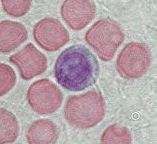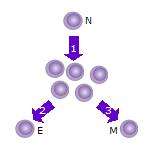Memory T cell


2. Some of the T cell clones will differentiate into effector T cells (E) that will perform the function of that cell (e.g. produce cytokines in the case of helper T cells or invoke cell killing in the case of cytotoxic T cells).
3. Some of the cells will form memory T cells (M) that will survive in an inactive state in the host for a long period of time until they re-encounter the same antigen and reactivate.
Memory T cells are a subset of infection- as well as potentially cancer-fighting T cells (also known as a T lymphocyte) that have previously encountered and responded to their cognate antigen; thus, the term antigen-experienced T cell is often applied. Such T cells can recognize foreign invaders, such as bacteria or viruses, as well as cancer cells. Memory T cells have become "experienced" by having encountered antigen during a prior infection, encounter with cancer, or previous vaccination. At a second encounter with the invader, memory T cells can reproduce to mount a faster and stronger immune response than the first time the immune system responded to the invader. This behaviour is utilized in T lymphocyte proliferation assays, which can reveal exposure to specific antigens.
Sub-populations
Within the overall memory T cell population, at least three distinct subpopulations have been described and can be recognised by the differential expression of chemokine receptor CCR7 and L-selectin (CD62L).[1]
- Stem memory TSCM cells, like naive cells, are CD45RO−, CCR7+, CD45RA+, CD62L+ (L-selectin), CD27+, CD28+ and IL-7Rα+, but they also express large amounts of CD95, IL-2Rβ, CXCR3, and LFA-1, and show numerous functional attributes distinctive of memory cells.[2]
- Central memory TCM cells express L-selectin and the CCR7, they secrete IL-2, but not IFNγ or IL-4.
- Effector memory TEM cells, however, do not express L-selectin or CCR7 but produce effector cytokines like IFNγ and IL-4.
More recently, other sub-populations have been explored using co-stimulatory molecules CD27 and CD28 expression in addition to CCR7 and CD62L.[3]
Function
Antigen-specific memory T cells against viruses or other microbial molecules can be found in both TCM and TEM subsets. Although most information is currently based on observations in the cytotoxic T cells (CD8-positive) subset, similar populations appear to exist for both the helper T cells (CD4-positive) and the cytotoxic T cells.
- central memory (TCM). The TCM cells are thought to contain some properties associated with memory cells stem cells. TCM display a capacity for self-renewal due to high levels of phosphorylation of an important transcription factor known as STAT5.[4] In mice, TCM cells have been shown to confer superior protection against viruses,[5] bacteria,[5] and cancer[6] in several different model systems compared with TEM cells.
- two highly related effector memory sub-types, which strongly express genes for molecules essential to the cytotoxic function of CD8 T cells:
- effector memory (TEM)
- effector memory RA (TEMRA)
- More recently, antigen-experienced CD8+ T cells with apparent self-renewal capabilities have been described in mice.[7][8] This population, now termed stem cell memory (TSCM), can be identified by the markers CD44(low)CD62L(high)CD122(high)sca-1(+) and are capable of generating TCM and TEM subsets while maintaining themselves. In preclinical studies, adoptively transferred TSCM confer superior immunity compared with other T memory subsets.[8] Whether such a population is found in humans is the subject of active investigation.
See also
References
- ↑ Sallusto F, Langenkamp A, Geginat J, Lanzavecchia A (2000). "Functional subsets of memory T cells identified by CCR7 expression". Curr. Top. Microbiol. Immunol. Current Topics in Microbiology and Immunology. 251: 167–71. doi:10.1007/978-3-642-57276-0_21. ISBN 978-3-540-67569-3. PMID 11036772.
- ↑ Gattinoni L1, Lugli E, Ji Y, Pos Z, Paulos CM, Quigley MF, Almeida JR, Gostick E, Yu Z, Carpenito C, Wang E, Douek DC, Price DA, June CH, Marincola FM, Roederer M, Restifo NP (September 2011). "A human memory T cell subset with stem cell-like properties". Nat Med. 17 (10): 1290–1297. doi:10.1038/nm.2446. PMID 21926977.
- ↑ Okada R, Kondo T, Matsuki F, Takata H, Takiguchi M (September 2008). "Phenotypic classification of human CD4+ T cell subsets and their differentiation". Int. Immunol. 20 (9): 1189–1199. doi:10.1093/intimm/dxn075. PMID 18635582.
- ↑ Willinger T, Freeman T, Hasegawa H, McMichael AJ, Callan MF (November 2005). "Molecular signatures distinguish human central memory from effector memory CD8 T cell subsets". Journal of Immunology. 175 (9): 5895–903. doi:10.4049/jimmunol.175.9.5895. PMID 16237082.
- 1 2 Wherry EJ, Teichgräber V, Becker TC, et al. (March 2003). "Lineage relationship and protective immunity of memory CD8 T cell subsets". Nature Immunology. 4 (3): 225–234. doi:10.1038/ni889. PMID 12563257.
- ↑ Klebanoff CA, Gattinoni L, Torabi-Parizi P, et al. (July 2005). "Central memory self/tumor-reactive CD8+ T cells confer superior antitumor immunity compared with effector memory T cells". Proceedings of the National Academy of Sciences of the United States of America. 102 (27): 9571–9576. doi:10.1073/pnas.0503726102. PMC 1172264
 . PMID 15980149.
. PMID 15980149. - ↑ Zhang Y, Joe G, Hexner E, Zhu J, Emerson SG (December 2005). "Host-reactive CD8+ memory stem cells in graft-versus-host disease". Nature Medicine. 11 (12): 1299–1305. doi:10.1038/nm1326. PMID 16288282.
- 1 2 Gattinoni L, Zhong XS, Palmer DC, et al. (July 2009). "Wnt signaling arrests effector T cell differentiation and generates CD8+ memory stem cells". Nature Medicine. 15 (7): 808–813. doi:10.1038/nm.1982. PMC 2707501
 . PMID 19525962.
. PMID 19525962.
Further reading
- Janeway, Charles (2005). Immunobiology: the immune system in health and disease. New York: Garland Science. ISBN 978-0-443-07310-6.
- Lichtman, Andrew H.; Abbas, Abul K. (2003). Cellular and molecular immunology. Philadelphia: Saunders. ISBN 0-7216-0008-5.